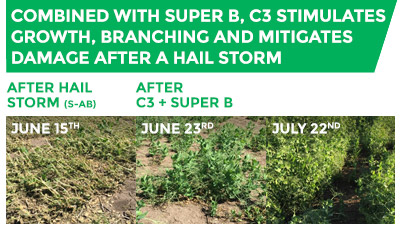Help for Hail-damaged Crops
One of the realities of farming on the Prairies is having to deal with intense and often unpredictable weather, including hail.
On average, Manitoba, Saskatchewan and Alberta see more severe thunderstorms and hailstorms than any other region in Canada. During peak hail season – the warm months of June through September – Prairie farmers will see approximately 130 hailstorms that are significant enough to do damage in the field. According to the Manitoba Agricultural Services Corporation (MASC), 2017 saw the highest hail claims in years.
Hail can cause a number of problems for crops, depending on the crop type and growth stage it’s at when a hailstorm hits. Injured plants, with leaves damaged and torn by hailstones, have difficulty completing photosynthesis. Without this vital source of energy, growth stalls and maturity is set back.
Help Crops Heal
Any amount of hail damage in an established crop can cause yield loss but, as long as there are viable plants standing, there is something you can do to help them heal and recover.
After damage has been assessed, providing your crop with nutrition in the form of a liquid foliar fertilizer with a high boron analysis, along with Stress Reliever Technology™, should be your first step to kickstart recovery – preferably within 48 to 72 hours after the storm.
Boron to the Rescue
 Boron promotes healing in wounded plants and is highly recommended for use after hail. As we read earlier in our Know Your Nutrients series, boron is an essential micronutrient, critical for cell division and structure, and sugar transport in the plant.
Boron promotes healing in wounded plants and is highly recommended for use after hail. As we read earlier in our Know Your Nutrients series, boron is an essential micronutrient, critical for cell division and structure, and sugar transport in the plant.
OMEX’s SuperB (10% boron) and KB78 (7% potassium and 8% boron) contain boric acid, the most-available form of boron, and are formulated for rapid foliar uptake.
For best results, we recommend using SuperB/KB78 with a metabolism-booster like NutriBoost, P3 or C3. These products are designed with Stress Reliever Technology™, to relieve plant stress and help crops bounce back by providing energy, mitigating tissue damage and stimulating branching and growth. This combination will also help protect the vulnerable leaves from further damage by insects, which may move in on the damaged crop.
Talk to your retailer or OMEX sales representative about an action plan to help crops heal after hail.
